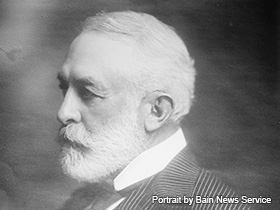Carnegie Company, Carnegie Steel Company, H.C. Frick Coke Company, Otterbein College, The Frick Collection, U.S. Steel Corporation, Westmoreland College
Henry Clay Frick attended Westmoreland College and Otterbein College. He created H.C. Frick Coke Company which began in the Connellsville region of Pennsylvania. He eventually became partners with Andrew Carnegie, a wealthy steel company owner. During his tenure in the coke and steel business he encountered many riots and strikes, the most infamous being the Homestead Steel Strike of 1892. Frick was also an avid art collector which later led to the creation of the Frick Collection. Frick held his partnership with Carnegie until 1899. Frick then became director of the U.S. Steel. He was also a well-known philanthropist.
Henry Clay Frick was born on December 19, 1849 in West Overton, Pennsylvania to John W. Frick and Elizabeth Overholt Frick. Frick was second of six children. As a boy, Frick spent most of his time with his maternal grandfather, Abraham Overholt. Overholt owned two whiskey businesses in which Frick eventually worked as an office boy. Attending Westmoreland College at the age of 16, Frick took classes in both math and history. He also attended Otterbein College in Westerville, Ohio for six weeks. Leaving West Overton for Pittsburgh at the age of 19, Frick found a room on the north side of Pittsburgh. Working for $6/hour, he was assigned to a linen and lace department of a wholesale dealer. In 1870 Frick entered the coal and coke business. Coke is the solid product resulting from the distillation of coal in a closed chamber by distillation, consisting primarily of carbon used as a fuel for stoves and furnaces and is necessary for the steel-making process.
Along with cousins Abraham Tinstman, J.S.R. Overholt, and Joseph Rist he created Frick and Company. Starting with just 150 coke ovens, Frick turned into a millionaire by the age of 30. A mill now referred to as Moreland was opened in 1877. Within five years the profits were $80,000-100,000 a year. By 1879, Frick became partners with brothers Edmund and Walton Ferguson. The renamed H.C. Frick and Company employed 1000 people and shipped 100 cars of coke a day. The company was responsible for eight out of every ten tons of Connellsville coking coal. Frick was selling $30,000 worth of coke a day. On December 15, 1881 Frick married Adeline Howard Childs. While honeymooning in New York, the couple sat down to lunch with Andrew Carnegie. Carnegie had never met Frick, but had used Frick coke for his Lucy Furnaces and his Edgar Thomson rail mill. Unknown to the others at the luncheon, besides Frick and Carnegie, one-half of Frick's coke works were already placed in a partnership between the two men. The once again renamed H.C. Frick Coke Company would be the exclusive supplier of coke for Carnegie's mills. Frick became chairman of not only his own coke company but Carnegie Steel Company as well.
During Frick's time as chairman he witnessed a number of riots and strikes at many mills due to demands for eight hour work days and higher wages. The most infamous of the strikes was the Homestead Steel Strike. Announcing that each worker would be dealt with on an individual basis, Frick brought in immigrant workers to replace those who weren't cooperative. He hired 300 Pinkerton Agents to stand guard at the mill after the announcement. Striking workers showed up in the middle of the night and battled with the agents. A total of ten men were killed but the event made national headlines.
In that same year a Russian anarchist, Alexander Berkman made an assassination attempt on Frick and ended up firing a revolver at his ear lobe and neck. Berkman also stabbed Frick four times. Frick returned to work a week later. By 1894, Frick was ready to resign as chairman of Carnegie Steel Company. This created tensions between Frick and Carnegie. Carnegie was going earnestly after Frick's assets. After a lawsuit, the two companies merged into Carnegie Company. Frick received over $25 million in the settlement. In 1901, Frick was given a position as director of what became U.S. Steel.
Eventually moving to New York, Frick established the Frick Collection- a mansion where Frick stored his enormous art collection. Frick died on December 2, 1919 in his bed at the age of 69. In his will Frick left only 1/6 of his fortune to his family. The other 5/6 was distributed to charitable institutions located in New York, Pittsburgh, and the West Overton- Connellsville Coke region. He left $6 million dollars to Princeton University, large sums to Harvard University, and the Massachusetts Institute of Technology. He also gave $1.5 million to the City of New York Lying-In Hospital (now the obstetrics and gynecology division of the New York Hospital-Cornell Medical Center). The public received his home and art collection worth some $15 million. In Pittsburgh, he left a park encompassing 151 acres, endowed with a $2 million trust. Frick also made generous donations to hospitals all over the Pittsburgh region.
- Harvey, George. Henry Clay Frick: The Man. New York City: Charles Scribner's Sons, 1928.
- "Pennsylvania- Henry Clay Frick." Netstate. 25 Feb. 2005. 15 Oct. 2006. <>http://www.netstate.com/states/peop/people/pa_hcf.htm>.
- Sanger, Martha Frick Symington. Henry Clay Frick: An Intimate Portrait. New York: Abbeville Press Publishers, 1998.
Born in West Overton, Henry Clay Frick came to control the coke industry and formed a partnership with Andrew Carnegie.

